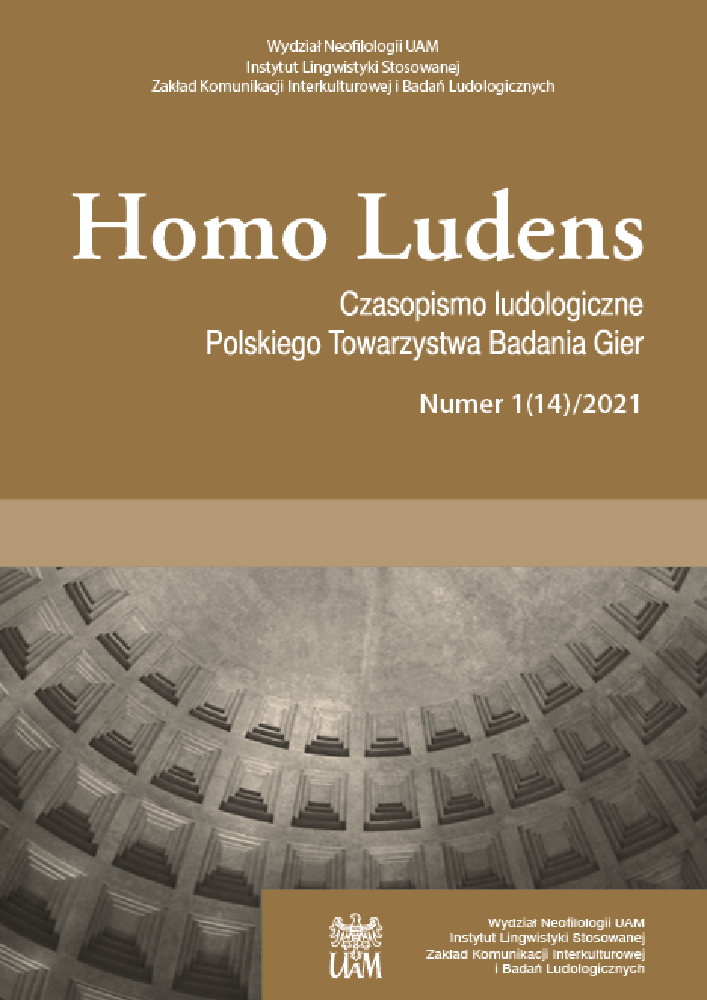Abstract
American popular culture in the nineties gave birth to the trend of pessimistic stories set in nightmare aesthetics. Authors of the games like Sanitarium recalled the memory of historical losses and also warned about future disasters. In this article the game made by the DreamForge Intertainment studio is analyzed as a representation of the damaged American identity. On the one hand, Sanitarium is about the social crisis that hit the USA at the end of the millennium. On the other hand, the meaning of the whole game is filled with trust in the recovery of America’s moral strength.
References
Buckland, W. (2009). Introduction. Puzzle plots. W: W. Buckland (red.), Puzzle films. Complex storytelling in contemporary cinema (s. 1–12). Malden: Wiley-Blackwell.
Fisher IV, B. F. (1981). The residual Gothic impulse: 1824–1873. W: M. B. Tymn (red.), Horror Literature. A Core Collection and Reference Guide (s. 176–189). New York: R. R. Bowker Company.
Foucault, M. (1987). Historia szaleństwa w dobie klasycyzmu (tłum. H. Kęszycka). Warszawa: Państwowy Instytut Wydawniczy.
Furedi, F. (2006). Culture of fear revisited. Risk-taking and the morality of low expectation. New York: Continuum International Publishing Group.
Glassner, B. (2000). The culture of fear. Why Americans are afraid of the wrong things. New York: Basic Books.
Hodgson, G. (2009). The myth of American exceptionalism. New Haven: Yale University Press.
Hofstadter, R. (1996). The paranoid style in American politics and other essays. Cambridge: Harvard University Press.
Huyssen, A. (2010). Twilight memories. Marking time in a culture of amnesia. New York: Routledge.
Kilgore, C. M. (2007). Medium of gameplay. Ames: praca magisterska.
Online: <https://dr.lib.iastate.edu/entities/publication/5b428dd67ccd-4bc2-841e-db7804adeda2>. Data dostępu: 28 grudnia 2019.
Kornberger, S. (2014). Vampire, Monster, irre Wissenschaftler. So viel Europa steckt in Hollywoods goldener Horrorfilmära. Hamburg: Diplomica Verlag.
Lamy, P. (1996). Millennium rage. Survivalists, white supremacists, and the doomsday prophecy. New York: Plenum Press.
Marak, K. (2021). “If the dog dies, I quit”: Blair Witch and the problems of contemporary psychological horror games. Studia Humanistyczne AGH, 20(2), 57–70.
Neal, A. G. (2005). National trauma and collective memory. London: Routledge.
Ott, C. (2012). Pumpkin. The curious history of an American icon. Seattle: University of Washington Press.
Pasetto, C (4 grudnia 1998). Postmortem. DreamForge’s Sanitarium. Online: <https://www.gamasutra.com/view/feature/3299/postmortem_dreamforges_sanitarium.php>. Data dostępu: 28 grudnia 2019.
Rautzenberg, M. (2015). Navigating uncertainty. Ludic epistemology in an age of new essentialisms. W: M. Fuchs (red.), Diversity of play (s. 83–106). Lüneburg: Meson Press.
Savoy, E. (2002). The rise of American Gothic. W: J. E. Hogle (red.), The Cambridge companion to Gothic fiction (s. 167–188). New York: Cambridge University Press.
Steger, M. B. (2009). Globalisms. The great ideological struggle of the twenty-first century. Lanham: Rowman & Littlefield Publishers.
Stohl, A. (2000). Der Narrenturm oder die dunkle Seite der Wissenschaft. Wien: Böhlau Verlag.
Tarnoff, B. (13 grudnia 2016). Neoliberalism turned our world into a business. And there are two big winners. Online: <https://www.theguardian.com/us-news/2016/dec/13/donald-trump-silicon-valley-leadersneoliberalism-administration>. Data dostępu: 28 grudnia 2019.
Troy, G. (2013). Morning in America. How Ronald Reagan invented the 1980’s. Princeton: Princeton University Press.
Valentine, K. D., Jensen, L.J. (2016). Examining the evolution of gaming and its impact on social, cultural, and political perspectives. Hershey: Information Science Reference.
Wheen, F. (2012). How mumbo-jumbo conquered the world. A short history of modern delusions. London: Harper Perennial.
Wiseman, G. (2001). Concepts of non-provocative defence. Ideas and practices in international security. London: Palgrave Macmillan.
Zinn, H. (2010). A people’s history of the United States, 1492–present. New York: Harper Perennial Modern Classics. Ebook.
Filmografia
małp (1995). Reż. T. Gilliam. USA.
Amerykański horror (1995–1996). USA.
Drabina Jakubowa (1990). Reż. A. Lyne. USA.
Gabinet doktora Caligari (1920). Reż. R. Wiene. Niemcy.
Millennium (1996–1999). USA.
Sucker Punch (2011). Reż. Z. Snyder. USA, Kanada.
Wyspa tajemnic (2010). Reż. M. Scorsese. USA.
Z Archiwum X (1993–2002). USA.
Ludografia
Black Isle Studios (1999). Planescape: Torment [PC]. Interplay Entertainment, USA.
Cyberdreams (1992). Dark Seed [PC]. Cyberdreams, USA.
Cyberdreams (1995). Dark Seed II [PC]. Cyberdreams, USA.
DigiFX Interactive (1996). Harvester [PC]. Merit Studios, USA.
DreamForge Intertainment (1995). Chronomaster [PC]. IntraCorp, USA.
DreamForge Intertainment (1998). Sanitarium [PC]. ASC Games, USA.
Team Silent (1999). Silent Hill [Playstation]. Konami, Japonia.
The Brotherhood Games (2015). Stasis [PC]. The Brotherhood Games, South Africa.
The Dreamer’s Guild (1995). I Have No Mouth, and I Must Scream [PC].
Cyberdreams, USA.

